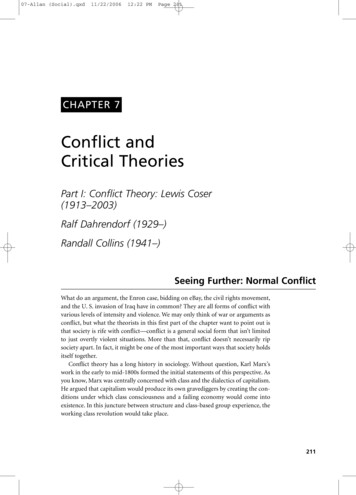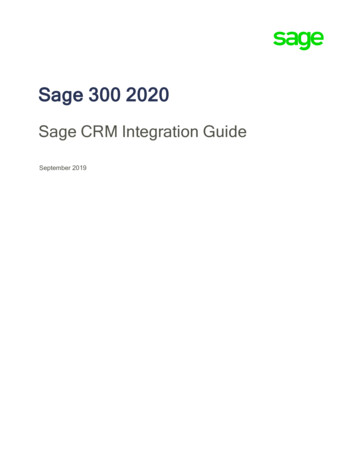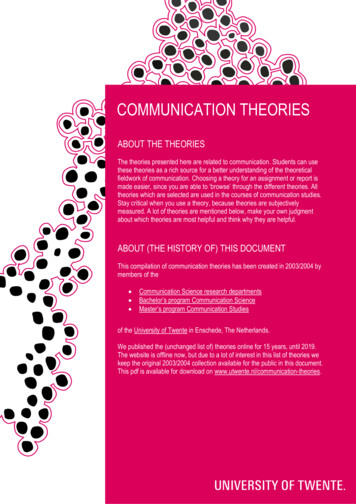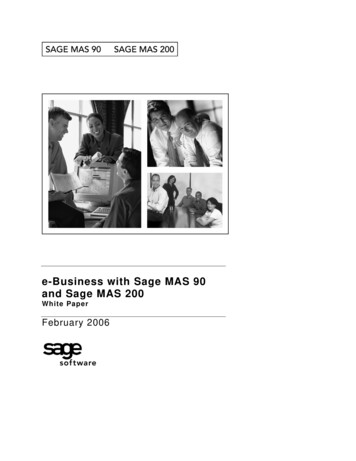
Transcription
07-Allan (Social).qxd11/22/200612:22 PMPage 211CHAPTER 7Conflict andCritical TheoriesPart I: Conflict Theory: Lewis Coser(1913–2003)Ralf Dahrendorf (1929–)Randall Collins (1941–)Seeing Further: Normal ConflictWhat do an argument, the Enron case, bidding on eBay, the civil rights movement,and the U. S. invasion of Iraq have in common? They are all forms of conflict withvarious levels of intensity and violence. We may only think of war or arguments asconflict, but what the theorists in this first part of the chapter want to point out isthat society is rife with conflict—conflict is a general social form that isn’t limitedto just overtly violent situations. More than that, conflict doesn’t necessarily ripsociety apart. In fact, it might be one of the most important ways that society holdsitself together.Conflict theory has a long history in sociology. Without question, Karl Marx’swork in the early to mid-1800s formed the initial statements of this perspective. Asyou know, Marx was centrally concerned with class and the dialectics of capitalism.He argued that capitalism would produce its own gravediggers by creating the conditions under which class consciousness and a failing economy would come intoexistence. In this juncture between structure and class-based group experience, theworking class revolution would take place.211
07-Allan (Social).qxd11/22/200612:22 PMPage 212212——THEORY CUMULATION AND SCHOOLS OF THOUGHTIn the early twentieth century, Max Weber formulated a response to Marx’stheory. Weber saw that conflict didn’t overwhelmingly involve the economy, butthat the state and economy together set up conditions for conflict. Of centralimportance to Weber’s scheme is the notion of legitimation. All systems of oppression must be legitimated in order to function. Thus, legitimation is one of thecritical issues in the idea of conflict. Weber also saw that class is more complex thanMarx initially supposed, and that there are other factors that contribute to socialinequality, most notably status and party (or power).Since that time, a number of efforts have combined different elements from oneor both of these theorists to understand conflict. In this chapter, we will considerthree of those efforts. Our first theorist is Lewis Coser. Coser’s work is interestingfor two reasons. First, he intentionally draws the majority of his theoretical ideasfrom Georg Simmel rather than Marx or Weber. Coser uses Marx and Weber nowand then to frame or elaborate upon what Simmel has to say, but by and large Coser(1956) presents “a number of basic propositions which have been distilledfrom theories of social conflict, in particular from the theories of Georg Simmel”(p. 8). Keep this in mind as we talk about Coser’s theory: we could easily substituteSimmel’s name for Coser’s.The second reason Coser is remarkable is that he is the first to consider the functional consequences of conflict—other than Simmel, that is. Before Simmel, conflict had been understood as a source of social change and disintegration. Simmelwas the first to acknowledge that conflict is a natural and necessary part of society;Coser brought Simmel’s idea to mainstream sociology, at least in America. Fromthat point on, sociologists have had to acknowledge thatgroups require disharmony as well as harmony, dissociation as well as association; and conflicts within them are by no means altogether disruptive factors. . . Far from being necessarily dysfunctional, a certain degree of conflict is anessential element in group formation and the persistence of group life. (Coser,1956, p. 31)In terms of the history of social thought and the layout of this book, it is interesting to note that Coser (1956) was motivated to consider the functional consequences of conflict to address a deficiency in Talcott Parsons’s theory: “Parsonsconsiders conflict primarily a ‘disease’” (p. 21). In the same vein, it is worthy of notethat Coser was a student of Merton’s.Our second theorist is Ralf Dahrendorf. He clearly blends elements from Marxand Weber and he sprinkles in elements from Coser to present a new understanding of conflict in society. From Marx he takes the idea of dialectical change: “socialstructures . . . are capable of producing within themselves the elements of theirsupersession and change” (Dahrendorf, 1957/1959, p. viii). If you don’t recallMarx’s use of the dialectic, I encourage you to look back at Chapter 1.Dahrendorf also uses Marx’s notion of political interests stemming from bipolarized social positions. Remember that Marx argued that capitalism contains onlytwo classes that really matter: the owners and the workers. These two positions are
07-Allan (Social).qxd11/22/200612:22 PMPage 213Conflict and Critical Theories——213inherently antagonistic and by their nature dictate different political interests;that is, all workers have the same political interests as do all owners. From Weber,Dahrendorf takes the idea of power and authority. Rather than seeing class as thecentral characteristic of modern society, Dahrendorf claims that power is the oneunavoidable feature of all social relations. In light of the theorists covered in theprevious chapter, it’s worth noting that Dahrendorf (1957/1959) regards Merton’stheories of the middle range as “the immediate task of sociological research” (p. x),and he sees his own theory as a necessary corrective of Parsons’s “equilibriumapproach.”On the other hand, our third conflict theorist, Randall Collins, is much lessconcerned with orienting his work around Parsons’s project. Rather, Collins (1975)draws on the work of Weber, Durkheim, and Goffman to argue that symbolic goodsand emotional solidarity are among the “main weapons used in conflict” (p. 59).This micro-level orientation is a unique and powerful addition to the conflict perspective. Most other conflict theories are oriented toward the macro level.Stratification is generally understood as operating through oppressive structuresthat limit access and choices (the idea of the “glass ceiling” is a good example), andpower is conceived of as working coercively through the control of materialresources and methods of social control. Collins also attunes us to a different levelof analysis than either Coser or Dahrendorf—the global level of geopolitics wherepolitical conflicts are analyzed within the context of history and geography.Defining Conflict TheoryIn general, conflict theory seeks to scientifically explain the general contoursof conflict in society: how conflict starts and varies, and the effects it brings. Thecentral concerns of conflict theory are the unequal distribution of scarce resourcesand power. What these resources are might be different for each theorist, but conflict theorists usually work with Weber’s three systems of stratification: class, status,and power. Conflict theorists generally see power as the central feature of society,rather than thinking of society as held together by collective agreement concerninga cohesive set of cultural standards, as functionalists do. Where power is located andwho uses it (and who doesn’t) are thus fundamental to conflict theory. In this wayof thinking about things, power isn’t necessarily bad: it is a primary factor thatguides society and social relations.
07-Allan (Social).qxd11/22/200612:22 PMPage 214214——THEORY CUMULATION AND SCHOOLS OF THOUGHTLewis Coser: The FunctionalConsequences of ConflictPhoto: Reprinted with permission of the American Sociological Association.The Essential CoserConcepts and Theory: Variation in ConflictBasic Sources of ConflictPredicting the Level of ViolenceConcepts and Theory: The Integrating Forces of ConflictInternal ConflictExternal ConflictCoser SummaryThe Essential CoserBiographyLewis Coser was born in Berlin, Germany, in 1913. His family moved to Paris in1933 where he studied literature and sociology at the Sorbonne. Because of hisGerman heritage, Coser was arrested and interned by the French governmentnear the beginning of WWII. He later was able to get political asylum in the
07-Allan (Social).qxd11/22/200612:22 PMPage 215Conflict and Critical Theories——215United States and arrived in New York in 1941. Coser did his Ph.D. work atColumbia University, where he studied under Robert K. Merton. His dissertation, The Functions of Social Conflict, took conflict theory in a new directionand was later named as one of the best-selling sociology books of the twentieth century by the journal Contemporary Sociology. Coser also authoredMasters of Sociological Thought, which became one of the most influentialsociological theory books in the English language. In addition, Coser established the Department of Sociology at Brandeis University; founded Dissentmagazine; served as president of the American Sociological Association (1975),the Society for the Study of Social Problems, and the Easter SociologicalAssociation (1983); and is honored annually through the American SociologicalAssociation’s Lewis A. Coser Award for Theoretical Agenda-Setting. Coser diedin July of 2003.Passionate CuriosityJames B. Rule (2003), writing in memoriam for Dissent magazine, said of Coser,he always considered himself an intellectual first and a sociologist second.His aim was always to make some sort of comprehensive sense of thehuman condition—a sense of the best that social life could offer and ahardheaded look at the worst things human beings could do to oneanother, a vision of possibilities of change for the better and an assessment of the forces weighing for and against those possibilities.Keys to KnowingCrosscutting influences, absolute deprivation, relative deprivation, rational andtranscendent goals, functional consequences of conflict, internal and externalconflict, types of internal conflict, network density, group boundaries, internalsolidarity, coalitionsConcepts and Theory: Variation in ConflictCoser argues that conflict is instinctual for us, so we find it everywhere in humansociety. There is the conflict of war, but there is also the conflict that we find in ourdaily lives and relationships. But Coser also argues that conflict is different forhumans than for other animals in that our conflicts can be goal related. There isgenerally something that we are trying to achieve through conflict, and there aredifferent possible ways of reaching our goal. The existence of the possibility of different paths opens up opportunities for negotiation and different types and levelsof conflict. Because Coser sees conflict as a normal and functional part of humanlife, he can talk about its variation in ways that others missed, such as the level ofviolence and functional consequences.
07-Allan (Social).qxd11/22/200612:22 PMPage 216216——THEORY CUMULATION AND SCHOOLS OF THOUGHTBasic Sources of ConflictFirst, we want to consider what brings on social conflict in the first place. AsI pointed out in the definition of conflict theory, most social conflict is based on theunequal distribution of scarce resources. Weber identified those resources for us asclass, status, and power. Weber, as well as Simmel, also pointed out the importanceof the crosscutting influences that originate with the different structures of inequality. For example, a working class black person may not share the same politicalinterests as a working class white person. The different status positions of these twopeople may cut across their similar class interests. Thus, what becomes importantas a source of social conflict is the covariance of these three systems of stratification.If the public perceives that the same group controls access to all three resources, itis likely that the legitimacy of the system will be questioned because people perceivethat their social mobility is hampered.The other general source of conflict comes from Marx. Marx’s concern was witha group’s sense of deprivation caused by class. This sense of deprivation is what leadsa group to class consciousness and produces conflict and social change. Marx wasprimarily concerned with explaining the structural changes or processes that wouldbring the working class to this realization, such things as rising levels of educationand worker concentration that are both structurally demanded by capitalism.Contemporary conflict theory has modified the idea of deprivation by notingthat it is the shift from absolute to relative deprivation that is significant in producing this kind of critical awareness. Absolute deprivation refers to the conditionof being destitute, living well below the poverty line where life is dictated by uncertainty over the essentials of life (food, shelter, and clothing). People in such a condition have neither the resources nor the willpower to become involved in conflictand social change.Relative deprivation, however, refers to a sense of being underprivileged relativeto some other person or group. The basics of life aren’t in question here; it’s simplythe sense that others are doing better and that we are losing out on something.These people and groups have the emotional and material resources to becomeinvolved in conflict and social change. But it isn’t relative deprivation itself thatmotivates people; it is the shift from absolute to relative deprivation that may sparka powder keg of revolt. People who are upwardly mobile in this way have the available resources, and they may experience a sense of loss or deprivation if the economic structural changes can’t keep pace with their rising expectations.Predicting the Level of ViolenceSimmel and Coser move us past these basic premises to consider the ways inwhich conflict can fluctuate. One of the more important ways that conflict can varyis by its level of violence. If people perceive conflict as a means to achieving clearlyexpressed rational goals, then conflict will tend to be less violent. A simple exchangeis a good example. Because of the tension present in exchanges, conflict is likely, but
07-Allan (Social).qxd11/22/200612:22 PMPage 217Conflict and Critical Theories——217it is a low-level conflict in terms of violence. People engage in exchange in order toachieve a goal, and that desired end directs most other factors. Another example isa worker strike. Workers generally go on strike to achieve clearly articulated goalsand the strikers usually do not want the struggle to become violent—the violencecan detract from achieving their goals (though strikes will become violent undercertain conditions). The passive resistance movements of the sixties and earlyseventies are other examples. We can think of these kinds of encounters as thestrategic use of conflict.However, conflict can be violent, and Coser gives us two factors that can produceviolent conflict: emotional involvement and transcendent goals. In order to becomeviolent, people must be emotionally engaged. Durkheim saw that group interactioncould increase emotional involvements and create moral boundaries around groupvalues and goals. He didn’t apply this to conflict, but Coser does. The more involvedwe are with a group, the greater is our emotional involvement and the greater thelikelihood of violent conflict if our group is threatened.Conflict will also tend to have greater levels of violence when the goals of agroup are seen to be transcendent. As long as the efforts of a group are understoodto be directed toward everyday concerns, people will tend to moderate their emotional involvement and thus keep conflict at a rational level. If, on the other hand,we see the goals of our group as being greater than the group and the concerns ofdaily life, then conflict is more likely to be violent. For example, when the UnitedStates goes to war, the reasons are never expressed by our government in mundaneterms. We did not say that we fought the First Gulf War in order to protect our oilinterests; we fought the war in order to defeat oppression, preserve freedom, andprotect human rights. Anytime violence is deemed necessary by a government, thereasons are couched in moral terms (capitalists might say they fight for individualfreedoms; communists would say they fight for social responsibility and the dignityof the collective). The existence of transcendent goals is why the Right to Life sideof the abortion conflict tends to exhibit more violence than advocates of choice—their goals are more easily linked to transcendent issues and can thus be seen asGod-ordained.Concepts and Theory:The Integrating Forces of ConflictCoser makes the case for two kinds of functional consequences of conflict: conflictthat occurs within a group and conflict that occurs outside the group. An exampleof internal conflict is the tension that can exist between indigenous populationsor first nations and the national government. Notice that this internal conflict isactually between or among groups that function within the same social system.Examples of external group conflicts are the wars in which a nation may involveitself. When considering the consequences for internal group conflict, Coser is concerned with low-level and more frequent conflict. When explaining the consequences for external conflict, he is thinking about more violent conflict.
07-Allan (Social).qxd11/22/200612:22 PMPage 218218——THEORY CUMULATION AND SCHOOLS OF THOUGHTInternal ConflictInternal conflict in the larger social system, as between different groups withinthe United States, releases hostilities, creates norms for dealing with conflict, anddevelops lines of authority and judiciary systems. Remember that Coser seesconflict as instinctual for humans. Thus, a society must always contend with thepsychological need of individuals to engage in conflict. Coser appears to argue thatthis need can build up over time and become explosive. Low-level, frequent conflicttends to release hostilities and thus keep conflict from building and becomingdisintegrative for the system.This kind of conflict also creates pressures for society to produce norms governing conflict. For example, most of the formal norms (laws) governing labor inWestern capitalist countries came about because of the conflict between labor andmanagement. We can see this same dynamic operating at the dyad level as well. Forexample, when a couple in a long-term relationship experiences repeated episodesof conflict, such as arguing, they will attempt to come up with norms for handlingthe tension in a way that preserves the integrity of the relationship. The same is truefor the social system, but the social system will go a step further and develop formalauthorities and systems of judgment to handle conflict. Thus, frequent, low-levelconflict creates moral and social structures that facilitate social integration.Coser also notes that not every internal conflict will be functional. It depends onthe types of conflict and social structure that are involved. In Coser’s theory, thereare two basic types of internal conflict: those that threaten or contradict the fundamental assumptions of the group relationship and those that don’t. Every group isbased on certain beliefs regarding what the group is about. Let’s take marriage as anexample of a group. For many people, a basic assumption undergirding marriage issexual fidelity. A husband and wife may argue about many things—such as finances,chores, toilet seats, and tubes of toothpaste—but chances are good that none of thesewill be a threat to the stability of the “group” (dyad) because they don’t contradict abasic assumption that provides the basis of the group in the first place. Adultery, onthe other hand, may very well put the marriage in jeopardy because it goes againstone of the primary defining features of the group. Conflict over such things ashousehold chores may prove to be functional in the long run for the marriage, whileadultery may be dysfunctional and lead to the breakup of the group.However, I want you to notice something very important here: In Coser’s way ofthinking about things, adultery won’t break a marriage up because it is morallywrong. Whether the relationship will survive depends on the couple’s basicassumptions as to its reasons for existence. A couple may have an “open marriage”based on the assumption that people are naturally attracted to other people andsexual flings are to be expected. In such a case, outside sexual relations will probably not break the group apart. Couples within such marriages may experience tension or fight about one another’s sexual exploits—and research indicates that theyoften do—but such conflict will tend to be functional for the marriage because ofits basic assumptions. Note also that conflict over household chores may indeed bedysfunctional if the underlying assumption of the marriage is egalitarianism, butthe actual division of labor in the house occurs along stereotypical gender lines.
07-Allan (Social).qxd11/22/200612:22 PMPage 219Conflict and Critical Theories——219The group structure will also help determine whether or not a conflict isfunctional. As Coser (1956) explains, “social structures differ in the way in which theyallow expression to antagonistic claims” (p. 152). To talk about this issue, let’s make adistinction based on network density. Network density speaks of how often a groupgets together, the longevity of the group, and the demands of the group in terms ofpersonal involvement. Groups whose members interact frequently over long periodsof time and have high levels of personal and personality involvement have high network density. Such groups will tend to suppress or discourage conflict. If conflict doeserupt in such a group, it will tend to be very intense for two reasons. First, the groupwill likely have built up unresolved grievances and unreleased hostilities. Once unfettered, these pent-up issues and emotions will tend to push the original conflict overthe top. Second, the kind of total personal involvement these groups have makesthe mobilization of all emotions that much easier. On the other hand, groups whosemembers interact less frequently and that demand less involvement—those with lownetwork density—will be more likely to experience the functional benefits of conflict.External ConflictThe different groups involved in conflict also experience functional results, especially when the conflict is more violent. As a group experiences external conflict, theboundaries surrounding the group become stronger, the members of the groupexperience greater solidarity, power is exercised more efficiently, and the grouptends to form coalitions with other groups (the more violent the conflict is, themore intensified are these effects). In order for any group to exist, it must includesome people and exclude others. This inclusion/exclusion process involves producing and regulating different behaviors, ways of feeling and thinking, culturalsymbols, and so forth. These differences constitute a group boundary that clearlydemarcates those who belong from those who do not.As a group experiences conflict, the boundaries surrounding the group becomestronger and better guarded. For example, during WWII the United States incarcerated those Americans of Japanese descent. Today we may look back at that incident with shame, but at the time it made the United States stronger as a collective;it more clearly demarcated “us” from “them,” which is a necessary function for anygroup to exist. Conflict makes this function more robust: “conflict sets boundariesbetween groups within a social system by strengthening group consciousnessand awareness of separateness, thus establishing the identity of groups within thesystem” (Coser, 1956, p. 34).Along with stronger external boundaries, conflict enables the group to also experience higher levels of internal solidarity. When a group engages in conflict, themembers will tend to feel a greater sense of camaraderie than during peacefultimes. They will see themselves as more alike, more part of the same family,existing for the same reason. Group-specific behaviors and symbols will be moreclosely guarded and celebrated. Group rituals will be engaged in more often andwith greater fervency, thus producing greater emotional ties between members andcreating a sense of sacredness about the group.
07-Allan (Social).qxd11/22/200612:22 PMPage 220220——THEORY CUMULATION AND SCHOOLS OF THOUGHTIn addition, a group experiencing conflict will tend to produce a more centralized power structure. A centralized government is more efficient in terms ofresponse time to danger, regulating internal stresses and needs, negotiating externalrelations, and so on. Violent conflict also tends to produce coalitions with previously neutral parties. Again, WWII is a clear example. The story of WWII is one ofincreasing violence with more and more parties being drawn in. Violent conflictproduces alliances that would have previously been thought unlikely, such as theUnited States being allied with Russia.Coalition . . . permits the coming together of elements that . . . would resistother forms of unification. Although it is the most unstable form of socialization, it has the distinct advantage of providing some unification where unification might otherwise not be possible. (Coser, 1956, p. 143)Coser Summary Contrary to the claims of most previous theorists, Coser argues that conflictcan have integrating as well as disintegrating effects. Conflict functions differentlywhether it is between unrelated groups (external) or inside a group, between factions (internal). For internal conflict, the question of functionality hinges on the conflictbeing less violent and more frequent, not threatening the basic assumptions of thegroup at large, and the group having low interactional network density. Under theseconditions, internal conflict will produce the following functional consequences:conflicts will serve to release pent-up hostilities, create norms regulating conflict,and develop clear lines of authority and jurisdiction (especially around the issuesthat conflict develops). External conflict that is more violent will tend to have the following functional consequences: stronger group boundaries, higher social solidarity, and moreefficient use of power and authority. Conflict violence will tend to increase in thepresence of high levels of emotional involvement and transcendent goals.Ralf Dahrendorf: Power and Dialectical ChangeWe move now to Ralf Dahrendorf ’s theory of power and dialectical change. LikeCoser, Dahrendorf sees conflict as universally present in all human relations. ButDahrendorf doesn’t see the inevitability of conflict as part of human nature; he seesit, rather, as a normal part of how we structure society and create social order. Inthis sense, Dahrendorf is concerned with the same issue as Talcott Parsons: How issocial order achieved? However, rather than assuming collective agreement aboutnorms, values, and social positions, as Parsons does, Dahrendorf argues that it ispower that both defines and enforces the guiding principles of society. Dahrendorfalso follows Coser in talking about the level of violence and its effects, butDahrendorf adds a further variable: conflict intensity.
07-Allan (Social).qxd11/22/200612:22 PMPage 221Conflict and Critical Theories——221Photo: Hulton Archives/Getty Images.The Essential DahrendorfConcepts and Theory: Power and Group InterestsPowerLatent and Manifest InterestsConcepts and Theory: Conflict Groups and Social ChangeConditions of Conflict Group FormationSocial ChangeDahrendorf SummaryThe Essential DahrendorfBiographyRalf Dahrendorf was born in Hamburg, Germany, on May 1, 1929. Hisfather was a Social Democratic politician and member of the German Parliamentwho was arrested and imprisoned by the Nazis during WWII. The youngerDahrendorf was arrested as well, fortuitously escaping death by only a few days.His father continued in politics after WWII in the Soviet-held portion ofGermany, but was again arrested, this time by the Soviets. He eventuallyescaped and fled with Ralf to England. Young Dahrendorf later returnedto Germany to study at the University of Hamburg, where he received his first
07-Allan (Social).qxd11/22/200612:22 PMPage 222222——THEORY CUMULATION AND SCHOOLS OF THOUGHTPh.D. in philosophy; he earned his second Ph.D. (sociology) in England atthe London School of Economics. Dahrendorf taught sociology at the universities of Hamburg, Tübingen, and Konstanz between 1957 and 1969. In 1969,Dahrendorf turned to politics and became a member of the German Parliament.In 1970, he was appointed a commissioner in the European Commission inBrussels. From 1974 to 1984, Dahrendorf was the director of the London Schoolof Economics. In 1988, Dahrendorf became a British citizen, and in 1993 he wasgiven life peerage and was named Baron Dahrendorf of Clare Market in the Cityof Westminster by Queen Elizabeth II. Sir Dahrendorf is currently a member ofthe House of Lords.Passionate CuriosityIn describing his own intellectual search, Dahrendorf (1989) says that it ismy firm belief that the regulation of conflict is the secret of liberty in liberal democracy. That if we don’t manage to regulate conflict, if we try toignore it, or if we try to create a world of ultimate harmony, we are quitelikely to end up with worse conflicts than if we accept the fact that peoplehave different interests and different aspirations, and devise institutions inwhich it is possible for people to express these differences, which is whatdemocracy, in my view, is about. Democracy, in other words, is not aboutthe emergence of some unified view from “the people,” but it’s aboutorganizing conflict and living with conflict.Keys to KnowingPower, authority, imperatively coordinated associations, Hobbesian problem ofsocial order, class, quasi-groups, interest groups, technical conditions, politicalconditions, social conditions, conflict violence and intensityConcepts and Theory:Power and Group InterestsPowerIt comes to this: dwarf-throwing contests,dwarfs for cent
211 CHAPTER 7 Conflict and Critical Theories Part I: Conflict Theory: Lewis Coser (1913-2003) Ralf Dahrendorf (1929-) Randall Collins (1941-) What do an argument, the Enron case, bidding on eBay, the civil rights movement,










